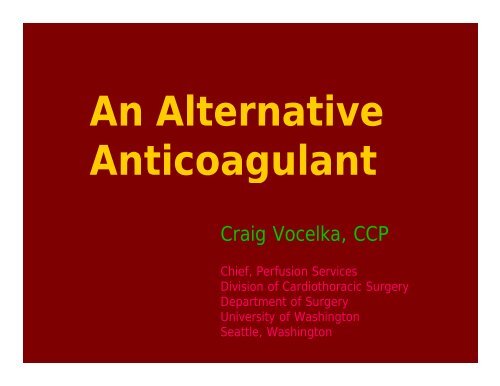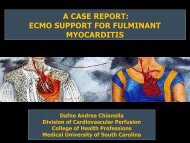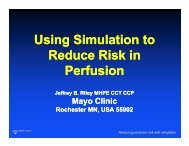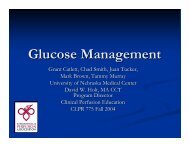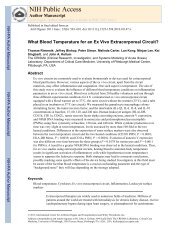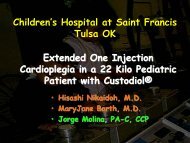PowerPoint Presentation (PDF) - Perfusion.com
PowerPoint Presentation (PDF) - Perfusion.com
PowerPoint Presentation (PDF) - Perfusion.com
You also want an ePaper? Increase the reach of your titles
YUMPU automatically turns print PDFs into web optimized ePapers that Google loves.
An Alternative<br />
Anticoagulant<br />
Craig Vocelka, CCP<br />
Chief, <strong>Perfusion</strong> Services<br />
Division of Cardiothoracic Surgery<br />
Department of Surgery<br />
University of Washington<br />
Seattle, Washington
Disclosure<br />
The University of Washington was part of<br />
the multi-center trial utilizing Angiomax<br />
(bivalirudin) for CPB.<br />
I have aereceived edno o<strong>com</strong>pensation pesato for<br />
participating in this study.<br />
I have received no <strong>com</strong>pensation from the<br />
Medicines Company for speaking.
McLean<br />
Discovered heparin to<br />
reduce blood clotting.<br />
First used Clinically in<br />
1933<br />
Heparin produced d in<br />
mast cells: Liver, Lungs,<br />
Gut, etc.<br />
Available 1950’s
Heparin: a natural product<br />
Combine 5,000 lbs. intestines, 200 gallons water, 10 gallons<br />
chloroform, and 5 gallons toluene. Hold at 90°F for 17 hours.<br />
Add 30 gallons acetic acid, 35 gallons ammonia, sodium hydroxide to<br />
adjust pH, and 235 gallons water. Bring to a boil; then filter.<br />
Add 200 gallons hot<br />
water to filtrate and<br />
allow to stand<br />
overnight, then skim off<br />
the fat.<br />
Keep pancreatic extract<br />
at 100°F for three days,<br />
then bring to boil.<br />
Filter solids and assay<br />
for heparin content.
Heparin and Protamine --<br />
Perfect Partners?<br />
“I don’t understand…I thought we were<br />
made for each other.”
Historical Perspective<br />
– 50+ Years of Cardiac Surgery using<br />
Heparin<br />
– Enabled Our Specialty to Grow and<br />
Prosper
Historical Perspective<br />
– 1960s and 1970s “Golden Age of Cardiac<br />
Surgery<br />
– 1980 PTCAs<br />
– 1990s coronary stents<br />
– Late 1990s OPCABS<br />
– 2001 2 million PTCAs worldwide<br />
d<br />
- Most <strong>com</strong>mon medical intervention<br />
– 2003 drug eluding stents
<strong>Perfusion</strong> Improvements<br />
• CLINICIANS and INDUSTRY<br />
• Early 1990s smaller “blood- friendly” oxygenators<br />
• Late 1990s Reduced Inflammation<br />
– Coated Circuits<br />
-Heparin<br />
– Aprotinin<br />
• Early 2000s Volume Reduction<br />
–RAP<br />
– Minimal Prime Circuits<br />
• Pump Sucker Sequestration
New Challenges<br />
PTCA<br />
Stents<br />
Drug Stents<br />
More and more patients<br />
having multiple<br />
exposures to heparin
thus…<br />
Heparin Antibodies<br />
Heparin Induced Thrombocytopenia
Thrombosis in HIT<br />
High risk for venous and arterial<br />
thromboemolism<br />
Propensity for venous limb gangerine<br />
????????????????????
Heparin- induced<br />
thrombocytopenia<br />
t A syndrome of in vivo thrombin generation<br />
Results from activation of platelets, endothelium,<br />
monocytes, coagulation pathways and<br />
inflammatory pathways.<br />
Antibody formation to heparin-PF4 <strong>com</strong>plex<br />
Hypercoagulable state with increased risk for<br />
venous and arterial thrombosis
Definition iti of Classic HIT<br />
1.Thrombocytopenia<br />
< 100,000 – 150,000 mm 3 (may not always see very<br />
low counts)<br />
or a 50% drop in platelet count from baseline (more<br />
powerful)<br />
2.Exclusion of other causes of thrombocytopenia<br />
3.With or without thrombotic <strong>com</strong>plications
Therapy for HIT<br />
Interruption of the immune response (eg.<br />
discontinue heparin)<br />
Reduce thrombin generation (thrombin<br />
inhibitors)<br />
Treatment of thrombosis
Ancrod<br />
Malaysain Pit Viper
Hirudins
Hirudin / Lepirudin / Bivalrudin<br />
Class of anticoagulants derived from leech<br />
spit<br />
Hirudin is the naturally occurring molecule<br />
65 amino acid peptide<br />
Lepirudin is a re<strong>com</strong>binant hirudin<br />
structurally almost identical to natural peptide<br />
Bivalirudin is a synthetic analog<br />
20 amino acid peptide<br />
1<br />
65
Mechanism of Action<br />
Blocks clotting activity of thrombin<br />
Binds 1:1 to thrombin (clot-bound and free)<br />
Independent of antithrombin III<br />
Not inhibited by Platelet Factor 4 (PF4)<br />
No cross reaction with HIT antibodies
Bivalurudin<br />
Direct Thrombin<br />
Inhibitor
Bivalirudin<br />
Marketed by The Medicines Company<br />
Trade name: Angiomax<br />
Approved for use in patients with unstable<br />
angina undergoing PTCA<br />
Reversible inhibition of thrombin<br />
Renal excretion<br />
Reduced dose only for severe renal<br />
insufficiency<br />
Monitor with ACT
Bivalirudin in CPB<br />
Off - label use<br />
CHOOSE and EVOLUTION<br />
Patients with / without history or risk of HIT
Heparin Bivalirudin<br />
“Shoot and forget”<br />
Long half life<br />
Variable response to<br />
AT-III<br />
Allergy<br />
Inflammatory reactions<br />
Protamine<br />
Short half life<br />
No reversal<br />
No allergy<br />
No inflammation<br />
ACT ?????<br />
“Not your father’s anticoagulant”<br />
Learn to over<strong>com</strong>e fear of change
Differences and Concerns<br />
Bolus and drip prior to bypass<br />
Flush solutions<br />
Cell Saver<br />
Cardioplegia<br />
dopega<br />
Termination of CPB<br />
Stagnant blood
<strong>Perfusion</strong>ist Issues<br />
Anticoagulation<br />
Bypass Circuit<br />
Cardiotomy Suction<br />
Cardioplegia<br />
Ultrafiltration<br />
“Cell Saver”
Anticoagulation<br />
ACT<br />
2.5 X Baseline<br />
q30min
Management<br />
Patient<br />
Flush<br />
Solution<br />
Pre CPB On CPB Post CPB<br />
1.0 mg/kg IV Bolus<br />
2.5 mg/kg/hr IV<br />
infusion<br />
2.5 mg/kg/hr IV<br />
infusion<br />
0.1 mg/ml 0.1 mg/ml 0.1 mg/ml<br />
Graft<br />
(Blood based) 1:12<br />
(Blood based) 1:12<br />
CPD or 0.1 mg/ml CPD or 0.1 mg/ml in<br />
Storage<br />
in crystalloid sol. crystalloid sol.<br />
Cell Saver CPD drip CPD drip CPD Drip<br />
Pump 50 mg in Prime 50 mg bolus in<br />
pump then 50<br />
mg/hr<br />
Plegia<br />
No additional
Circuit<br />
Non coated circuit<br />
Add A-V bridge at table using ¼ tubing
Cardiotomy Suction<br />
If suctions are use, set cardiotomy height so<br />
there is no pooling in cardiotomy<br />
reservoir
Hemoconcentration<br />
ACT<br />
bolus of 0.3mg/kg<br />
double trip rate
Cardioplegia<br />
4:1 blood<br />
flush line at table prior to each infusion
Cell Saver<br />
Citrate as anticoagulant<br />
Use 1500 ml wash<br />
Check Ionized Calcium if there are<br />
significant volumes from CS, treat if<br />
clinically meaningful hypocalcemia is<br />
diagnosed
Use of Bivalirudin During CPB<br />
Dosing for open heart surgery<br />
1 mg/kg loading dose<br />
2.5 mg/kg/hour infusion dose started when loading<br />
dose given<br />
50 mg in the perfusion circuit prime
Anticoagulation Monitoring<br />
A kaolin based act system is used in our hospital<br />
After loading dose is given to the patient expect an<br />
increased ACT of 2.5 times baseline<br />
A continuous infusion of 2.5 mg/kg/hr maintains the<br />
ACT at this target throughout bypass run<br />
Monitor the ACT every thirty minutes unless the<br />
patient is being hemoconcentrated<br />
If hemoconcentrating the patient then monitor the<br />
ACT every 15 minutes as the hemoconcentrator<br />
does remove bivalirudin<br />
If the ACT should fall below the 2.5 threshold the<br />
patient can be rebolused with a dose of 0.2 to 0.5<br />
of the initial loading dose. Adjusting the drip will not<br />
raise the drug level in a timely manner
Use of Bivalirudin During CPB<br />
No need to redesign circuit<br />
Normal <strong>com</strong>ponents are set up in the standard fashion<br />
The overriding concern is the elimination of areas of<br />
blood stasis throughout the circuit<br />
Either an open system or a closed system may be used<br />
Retrograde autologous priming may be used as long as<br />
initiation of bypass is within minutes<br />
Keep level in venous reservoir around 1000 to 1200<br />
mls. Put any excess volume in CPD bags for later use<br />
Put clamp high on bypass loop around arterial filter to<br />
diminish stagnant blood in tubing<br />
Put floppysucker in left chest to remove stagnant blood
Use of Bivalirudin During CPB<br />
Cardioplegia administration<br />
Using bivalirudin on bypass does not affect the choice of<br />
cardioplegia, cold or warm, crystalloid or blood based,<br />
or the route of administration, antegrade or retrograde.<br />
When using crystalloid cardioplegia it is administered in its<br />
usual manner<br />
When using blood based cardioplegia the time between<br />
doses should be minimized to avoid clots in the<br />
cardioplegia line. It is our practice to give cardioplegia<br />
after every distal or every 15 minutes which is routine<br />
in many clinical situations. If the time between doses is<br />
longer then it would be prudent to flush the line at the<br />
table before each dose.
Use of Bivalirudin During CPB<br />
Weaning from bypass<br />
Make sure the patient is warmed to 37 degrees C<br />
Weaning from bypass is routine. If the patient is<br />
stable at 10 to 15 minutes the volume can be<br />
moved over to the cell saver and processed and<br />
returned to the patient.<br />
If there is a delay in emptying the perfusion circuit,<br />
blood should be re-circulated either through an<br />
existing bridge or by putting a 3/8” to 1/2”<br />
connector on the table and reconnecting the AV<br />
loop. An additional 50 mgs of bivalirudin should be<br />
added to this circuit.
Special Considerations<br />
Cell saver use is re<strong>com</strong>mended and CPD can be used as an<br />
anticoagulant. What amounts of bivalirudin the process of cell<br />
saving removes are unclear at this time as there is no data.<br />
As mentioned earlier hemoconcentration will remove circulating<br />
bivalirudin. Anticoagulation protocols must be monitored more<br />
closely and rebolusing used if the act levels fall below the 2.5<br />
baseline threshold.<br />
At the present time it is unclear what impact, if any, the<br />
numerous coatings that are available have on a routine patient<br />
receiving bivalirudin. It is important to avoid heparin coated<br />
circuits and heparin coated catheters on a patient with HIT/TS.<br />
In an emergent conversion to CPB from OPCAB we re<strong>com</strong>mend<br />
rebolusing the patient with a 0.5mg/kg dose followed by a<br />
2.5mg/kg/hr infusion. Also 50 mg should be added to the<br />
cardiopulmonary bypass circuit. ACT values of 2.5 times<br />
baseline should be expected.
Summary<br />
or In my opinion……<br />
Safe anticoagulant for CPB<br />
Need to look at ACT in a new light<br />
Avoid stasis in circuit<br />
Calls for increased <strong>com</strong>munication among<br />
surgeon, anesthesiologist, i and perfusionist<br />
i
Once again….<br />
This is not heparin<br />
It has been used with success<br />
The ACT is now a relative number<br />
Avoid stagnation<br />
Don’t be afraid of change
Thank<br />
you<br />
for<br />
your<br />
attention
One final question<br />
Does anyone recognize this man?


